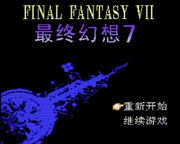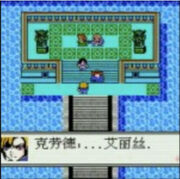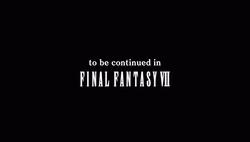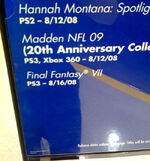The game followed in the footsteps of Final Fantasy VI in presenting a world with considerably more advanced technology than previous installments. The gamut of the game's technology covers space flight, robotics, highly advanced genetic engineering, automatic firearms, directed energy weapons, automobiles, helicopters, limited antigravity technology, and major global corporations; the level of technology in the world of Final Fantasy VII could be said to approximate that of near-future science fiction.
The game incorporates references to a variety of religious and philosophical systems, reflected in character names like Sephiroth (drawn from the Kabbalah) and Heidegger (likely a reference to German philosopher Martin Heidegger), and place names such as Midgar and Nibelheim (both from Norse mythology), as well as numerous references in monster names, such as the Midgar Zolom, a reference to the Midgardsorm (also from Norse mythology). Additionally, several references are made to previous Final Fantasy titles, including several character names such as Cid and Biggs and Wedge, and the repetition of soundtrack motifs, such as the chocobo theme.
After being deeply unhappy with the Ted Woolsey supervised translation of Final Fantasy VI (which was generally well done, but drastically altered some parts of the game's storyline), Sakaguchi insisted that the game's English translation be conducted in-house by the original Japanese development team, as had been done with Final Fantasy and Final Fantasy IV. Although the resulting translation was perhaps more true to the Japanese version than the previous game had been, it was criticised by some as being awkward and contained numerous grammatical errors. The Windows port uses the same localization script, but several of the more egregious errors were corrected. In future games, Square would hire American translators to collaborate with the Japanese development team, instead of having the translation done entirely by one or the other.
The game was a critical and commercial success. It received glowing reviews from most video game magazines and by 1999 the game had sold more than eight million copies worldwide, with about 3 million in the first 48 hours of its release. It was one of the first console role-playing games to achieve widespread popularity outside of Asia, and the ongoing popularity of the title led Square Enix to produce a series of sequels and prequels under the collective title Compilation of Final Fantasy VII in the mid-2000s.
Not counting spin-off or related titles (such as Final Fantasy Mystic Quest), Final Fantasy VII was the first Final Fantasy title to be released in Europe and Australia, and it was the first Final Fantasy game to be released under the same name in both Japan and North America since the original NES Final Fantasy (aka Final Fantasy I). This fact caused some initial confusion among North American consumers. Japan's Final Fantasy II, III, and V were not released in North America. Instead, Final Fantasy IV and Final Fantasy VI were released as America's Final Fantasy II and III respectively. The American series thus effectively jumped from III to VII when Final Fantasy VII was released in North America, although the game was in fact the next sequential release. It caused even more confusion among European consumers, who praised the game like everyone else, but thought there were 6 other games that dealt with Cloud and his friends' adventures.
[edit] Final Fantasy VII International
The North American and PAL versions of Final Fantasy VII made substantial changes to the original Japanese version. Several areas of gameplay had been made more difficult by adding in new bosses. Random battle rates had been cut down, and Materia swapping between characters was made easier. Along with this, a flashback of Cloud and Zack was added in. A re-release of the North American version of Final Fantasy VII was made in Japan only, called "Final Fantasy VII International", the very first International Version, a semi-recurring feature of the series. It included a special fourth disc that gave maps, character information, design sketches and other trivia.
[edit] Compilation of Final Fantasy VII
- Main article: Compilation of Final Fantasy VII
After the new millennium began, Yoshinori Kitase and Tetsuya Nomura were approached and asked for a game that could be expanded across multiple platforms and mediums. Final Fantasy VII was chosen, which led to the creation of the Compilation of Final Fantasy VII. To date, the compilation includes two mobile phone games, one sequel game, one prequel game, one full-length CGI film, an OVA, and several short novellas. The games within the collection have expanded on the story of Final Fantasy VII both before and after the original game, but have been met with mixed reactions for a number of reasons, including various retcons and liberties taken with the original storyline and characters. According to remarks from Kitase, the Compilation will continue to be expanded upon, and will conclude on the original game's 20th anniversary.
[edit] Pirated Famicom Version
In 2005 the Chinese company, ShenZhen Nanjing Technology, created an unofficial port of Final Fantasy VII on the Nintendo Famicom. This version is not licenced by either Square Enix or Nintendo. Oddly, this game makes a reference to Advent Children, though it has nothing to do with that movie or any sequel. The plot is pretty much the same as the original, but large sections have been lost. After the events of the Northern Crater, this version skips over the WEAPONs and Huge Materia and jumps right to the final battle. Since it is a port onto a system with far lower technical capabilities than the PlayStation, the Famicom version is a greatly stripped-down version.
Graphics are 8-Bit, and often crude copies of sprites from NES era Final Fantasy titles. For example, Cloud's sprite is the Fighter sprite from Final Fantasy with yellow hair. Safer Sephiroth is an obvious copy of the Cloud of Darkness. The soundtrack is largely lifted from Final Fantasy II and Final Fantasy III, as no attempt was made to recreate Final Fantasy VII's tracks in 8-Bit form. The entire game is written in Chinese.Much of the gameplay is lost as well. Summons, Limit Breaks, the optional characters, and nearly all of the sidequests have been removed. There are only six healing items and Materia is severely limited. Since the plot has been cut down, there is no Airship, and thus areas only accessible via Airship are gone. For unknown reasons, Mount Nibel and Fort Condor have also been removed. The game's battle system is very difficult, as leveling and Materia growth have been made slower. Random battles are also much more common. Gamers, however, said that it was fun to play- if one cheats.
The game can be played on any Famicom or on the NES using an adaptor. It has an unique cartridge that looks nothing like licenced Famicom cartridges.
[edit] Final Fantasy VII on PS3?
In 2005 at the Sony E3 annual press conference, Square Enix showed a Technical Demo for the PS3 depicting the opening sequence to the original Final Fantasy VII. Although rumors remained uncorroborated for a time, Square-Enix has made an official statement that there are currently no plans of a remake of Final Fantasy VII for the PS3.
The rumors were sparked a second time recently with Square Enix' exhibition of new FMV artworks during the Final Fantasy VII 10th Anniversary event in Japan. The artworks depict the characters in their FFVII costumes, sparking rumors that a remake of the game may be in development. [1] These CG artworks were printed on their new canned Potion beverages. Kazuo Hirai, the president of Sony Computer Entertainment Japan, has also fueled the rumors by sticking a small note in the exhibition saying "Congratulations for the ten fantastic years! The best is yet to come".
The rumors of a Final Fantasy VII remake on the PS3 have recently been sparked again with the release of Crisis Core -Final Fantasy VII-. The ending shows the beginning of Final Fantasy VII in a more modern CG style, followed by a title card reading "to be continued in FINAL FANTASY VII". While it's possible this is hinting at a remake, it may also be implying the continuation of the story for those who never played Final Fantasy VII.
Rumors of a Final Fantasy VII PS3 remake were sparked even more, due to photos of a Best Buy ad stating that the game was to be released on August 16. But this was obviously false since the date had passed.
Despite excitement surrounding the possible remake, Square Enix has denied any and all rumors on several occasions. With photos of an ad for CLOUD Vol.2 appearing on the Internet, the possibilities of a remake have been risen yet again. The ad has been revealed to be for a book, although details about its contents have not yet been released.From : http://finalfantasy.wikia.com/wiki/Final_fantasy_7






Tidak ada komentar:
Posting Komentar